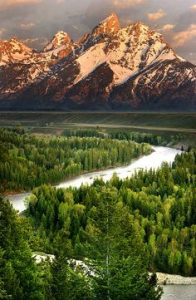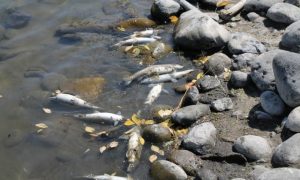Tiny Invaders

 Summers are warmer now compared to when I started rafting in the early 1980’s. And we have less water. To the untrained eye, Grand Teton’s Snake River looks fast and deep, but it’s deceptive. At Deadman’s Bar, our float trip launch point, the river is confined to one narrow channel and moves along quickly due to an eighteen feet per mile gradient. Once the river starts braiding and splitting, the water gets quite shallow. At this time of year, we’re often navigating river flows that are around 3,000 cfs (that’s cubic feet of water per second). In contrast, during the spring snowmelt in late June, we might see flows of up to 14,000 cfs. Why the large difference? The Snake River’s flow is regulated by a dam built in 1916, prior to the formation of the park. The flows we see are maintained in a complicated balancing act between flood control to protect local subdivisions along the river, recreational needs in Jackson Hole, and agricultural uses in Idaho.
Summers are warmer now compared to when I started rafting in the early 1980’s. And we have less water. To the untrained eye, Grand Teton’s Snake River looks fast and deep, but it’s deceptive. At Deadman’s Bar, our float trip launch point, the river is confined to one narrow channel and moves along quickly due to an eighteen feet per mile gradient. Once the river starts braiding and splitting, the water gets quite shallow. At this time of year, we’re often navigating river flows that are around 3,000 cfs (that’s cubic feet of water per second). In contrast, during the spring snowmelt in late June, we might see flows of up to 14,000 cfs. Why the large difference? The Snake River’s flow is regulated by a dam built in 1916, prior to the formation of the park. The flows we see are maintained in a complicated balancing act between flood control to protect local subdivisions along the river, recreational needs in Jackson Hole, and agricultural uses in Idaho.
I bring up the subject of warmer summers because one of the side effects of higher air temperatures is warmer water. Warm water seems like a good idea – it’ll make your whitewater trip or paddleboard adventure much more comfortable. But higher lake and river temperatures can be harmful to fish and place stress on delicate mountain ecosystems. The recent closure of 180 miles of the Yellowstone River in Montana to all recreational uses made national headlines. It turns out that a small parasite recently arrived in this fishing mecca, resulting in the deaths of tens of thousands of Whitefish, an important indicator species. This tiny invader is a parasite tetracalsula bryosalmonae that thrives in poor river conditions – think warmer water and low stream flows – and causes kidney failure in affected fish populations. Human health is unaffected, but the impact to our local economy may be devastating. Like Jackson Hole, the Paradise Valley and towns like Livingston and Gardiner depend on tourism, and an unprecedented river closure during the peak season will hit us where it hurts.
 How did this parasite arrive on the Yellowstone? It’s not native to Montana but has been spotted in the neighborhood, most recently in eastern Idaho on the Henry’s Fork of the Snake. And it’s most likely that this parasite hitched a ride to Montana on someone’s fishing gear. For many years, the National Park Service and the Fish and Game Department have urged water users clean equipment whenever they move from one watershed to another, to avoid transporting harmful exotics. But the message doesn’t seem to have reached everyone. And with more and more visitors flocking to our rivers, lakes, and parks each year, the need for education has never been more vital.
How did this parasite arrive on the Yellowstone? It’s not native to Montana but has been spotted in the neighborhood, most recently in eastern Idaho on the Henry’s Fork of the Snake. And it’s most likely that this parasite hitched a ride to Montana on someone’s fishing gear. For many years, the National Park Service and the Fish and Game Department have urged water users clean equipment whenever they move from one watershed to another, to avoid transporting harmful exotics. But the message doesn’t seem to have reached everyone. And with more and more visitors flocking to our rivers, lakes, and parks each year, the need for education has never been more vital.
Is there a solution? Sort of. We can vote for lawmakers who support policies that will address the effects of carbon emissions on global temperatures. But for now, we can commit to thoroughly cleaning our river equipment after each use, or dedicating equipment to one watershed only. And let’s all be sure to cooperate at watercraft inspection stations in our parks and along our waterways. Our Barker-Ewing river guides stop at the inspection station in Moose before every single scenic trip – and we’re happy to do it for the sake of the Snake, to help ensure the health of this waterway and preserve it for all to enjoy.
